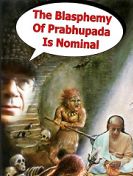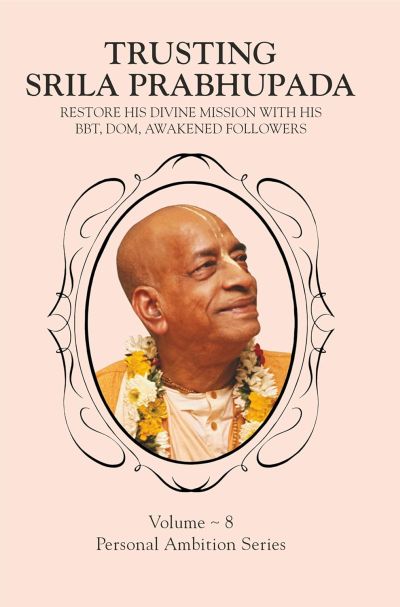
Prabhupada: In the material world the topmost planet is called Satyaloka, or Brahmaloka. Beings of the greatest talents live on this planet. The presiding deity of Brahmaloka is Brahma, the first created being of this material world. Brahma is a living being like so many of us, but he is the most talented personality in the material world. He is not so talented that he is in the category of God, but he is in the category of those living entities directly dominated by God. God and the living entities both belong to the antimaterial world. The scientist, therefore, would be rendering service to everyone by researching the constitution of the antimaterial world–how it is administered, how things are shaped there, who are the presiding personalities, and so on.
Of the Vedic literatures, Srimad-Bhagavatam deals elaborately with these matters. The Bhagavad-gita is the preliminary study of the Srimad-Bhagavatam. These two important books of knowledge should be thoroughly studied by all men in the scientific world. These books would give many clues to scientific progress and would indicate many new discoveries.
 The transcendentalists and the materialists are two distinct classes of men. The transcendentalist gathers knowledge from authoritative scriptures like the Vedas. Vedic literature is received from authoritative sources which are in the line of transcendental disciplic succession. This disciplic succession (parampara) is also mentioned in the Bhagavad-gita. Krishna says in the Bhagavad-gita that hundreds of thousands of years ago the Gita was spoken to the presiding deity of the sun, who delivered the knowledge to his son Manu, from whom the present generation of man has descended. Manu, in his turn, delivered this transcendental knowledge to his son King Iksvaku, who is the forefather of the dynasty in which the Personality of Godhead Sri Rama appeared. This long chain of disciplic succession was broken during the advent period of Lord Krishna (five thousand years ago), and for this reason Krishna restated the Bhagavad-gita to Arjuna, thereby making him the first disciple of this knowledge in this age. The transcendentalist of this age, therefore, is in the disciplic line that starts with Arjuna. Without troubling himself with materialistic research work, the transcendentalist acquires the truths concerning matter and antimatter in the most perfect way (through this disciplic succession) and thereby saves himself much botheration.
The transcendentalists and the materialists are two distinct classes of men. The transcendentalist gathers knowledge from authoritative scriptures like the Vedas. Vedic literature is received from authoritative sources which are in the line of transcendental disciplic succession. This disciplic succession (parampara) is also mentioned in the Bhagavad-gita. Krishna says in the Bhagavad-gita that hundreds of thousands of years ago the Gita was spoken to the presiding deity of the sun, who delivered the knowledge to his son Manu, from whom the present generation of man has descended. Manu, in his turn, delivered this transcendental knowledge to his son King Iksvaku, who is the forefather of the dynasty in which the Personality of Godhead Sri Rama appeared. This long chain of disciplic succession was broken during the advent period of Lord Krishna (five thousand years ago), and for this reason Krishna restated the Bhagavad-gita to Arjuna, thereby making him the first disciple of this knowledge in this age. The transcendentalist of this age, therefore, is in the disciplic line that starts with Arjuna. Without troubling himself with materialistic research work, the transcendentalist acquires the truths concerning matter and antimatter in the most perfect way (through this disciplic succession) and thereby saves himself much botheration.
The gross materialists, however, do not believe in the antimaterial worlds of the Personality of Godhead. They are therefore unfortunate creatures, although sometimes very talented, educated and advanced otherwise. They are bewildered by the influence of the material manifestation and are devoid of knowledge of things antimaterial. It is a good sign, therefore, that the materialistic scientists are gradually progressing toward the region of the antimaterial world. It may even be possible for them to make sufficient progress to be able to know the details of this antimaterial world, where the Personality of Godhead resides as the predominating figure and where the living entities live with Him and serve Him. The living entities who serve the Godhead are equal in quality to Him, but at the same time they are predominated as servitors. In the antimaterial world there is no difference between the predominated and the predominator–the relationship is in perfection and without tinge of materialism.
The nature of the material world is destructive. According to the Bhagavad-gita, there is some partial truth to the assumption of the physical scientist that there is annihilation of the material and antimaterial worlds when they chance to clash. The material world is a creation of changing modes of nature. These modes (gunas) are known as sattva (goodness), rajas (passion) and tamas (ignorance). The material world is created by the mode of rajas, maintained by the mode of sattva, and annihilated by the mode of tamas. These modes are omnipresent in the material world, and as such, at every hour, every minute, every second, the process of creation, maintenance and annihilation is taking place all over the material universe. The highest planet of the material universe, Brahmaloka, is also subjected to these modes of nature, although the duration of life on that planet, due to the predominance of the mode of sattva, is said to be 4,300,000 x 1,000 x 2 x 30 x 12 x 100 solar years. Despite this long duration, however, Brahmaloka is subject to destruction. Although life on Brahmaloka is fantastically long compared to life on Earth, it is only a flash in comparison to the eternal life of the nonmaterial worlds. Consequently, the speaker of the Bhagavad-gita, Lord Sri Krishna, asserts the importance of the antimaterial universe, which is His abode.
Full Book, “Easy Journey to Other Planets”: http://prabhupadanugas.eu/books/EJtOP.html







very good coment by sri praphupada no history makes me read more than your books .i hope that i can read and understand the bhagavad gita .